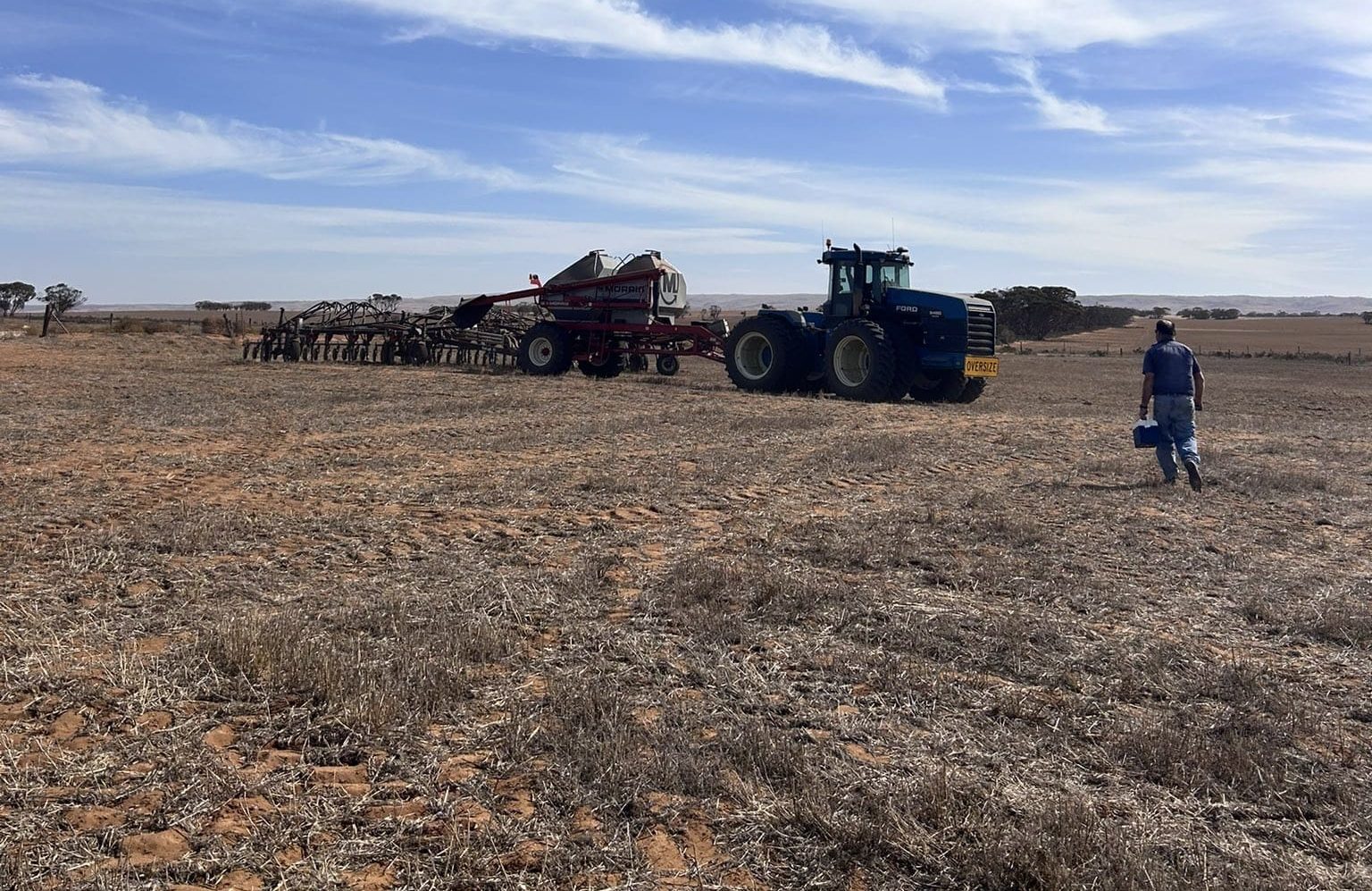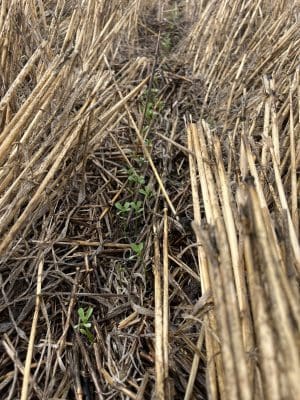
Planting lentils this week in SA’s Murray-Mallee region, where rain is needed soon to germinate dry-sown crops. Photo: Rebekah Starick
PLANTING of faba beans and lentils is well under way, with dry sowing ticking along in South Australia and Victoria as growers wait for the autumn break.
In Queensland and central and northern New South Wales, planting conditions are mostly ideal, and too wet in places, for faba beans.
Planting of desi chickpeas has just started in the southernmost growing regions north-west of Dubbo in NSW, and will start in Qld and in the far north and north-west of NSW in coming weeks.
Some early lentil crops are up and away in Vic, but are few and far between in SA, where widespread rain is needed by early June to keep prospects alive for an average crop.
After a hectic first half of exports, trade in chickpeas, faba beans and lentils has slowed considerably.
All prices quoted are in Australian dollars per tonne unless stated otherwise.
Chickpeas
New-crop chickpeas are nominally quoted at $860/t for November-December delivery to Brisbane.
“Growers are not jumping yet; they’re keen to get the seed in the ground and go from there,” Sunrise Commodities managing director Scott Merson said.
Unistar Grains director Sanjiv Dubey said Australian chickpeas were now subject to a 10-percent duty from India, down from around 80pc at the height of the previous tariff period which ended last year.
He said India’s harvest of its own rabi crop was drawing to a close, and adding to price pressure after India’s massive import program from Australia.
“India’s bought a lot from Australia, and they’re having a decent crop themselves, so the markets are soft,” Mr Dubey said.
“On the other hand, Pakistan has taken up whatever is left; they had a smaller production than was anticipated.”
Mr Dubey said the Australian dollar’s recent drop in value to around US 60 cents sweetened the market for Australian exporters and growers in the tail end of the export period.
“What has helped on the Australian side is the dollar.
In AUD terms, values now are around where they were at this time last year.
Mr Dubey is not expecting forward sales from growers before the crop is planted.
“I think in another month or so, we’ll see selling.”
Australia’s current chickpea crop was one of the best yielding ever and, provided conditions dry out enough in Qld and northern NSW to allow all intended area to be planted, another bumper crop could be on the way if growing-season weather is kind.
“The indication I’m getting is planting is going to be larger than last year.
“Northern NSW has been fairly wet; they want it to dry out a little.”
At Narromine in NSW, Ag N Vet agronomist Mick Harris said planting of chickpeas in his client base has started today.
The Narromine district had good rain in late March, and country has dried out sufficiently to allow planting this and next week.
“Mid May is the ideal time for us for planting chickpeas,” Mr Harris said.
Faba beans
Australia is nearing the end of its bulk faba bean program, with most recent shipments being dual or multi-port loads, including a 5000t parcel from Albany in WA’s Great Southern region.
This is believed to be a first for WA’s southernmost port, loaded with Commodity Ag’s mobile shiploader over three days, with the vessel’s other holds filled in SA’s Port Adelaide and Port Lincoln, as well as Geelong in Vic.
“This is a terrific result for one of our newer customers as it continues to establish itself as an exporter in the global market as well as for growers in the Great Southern,” Southern Ports chief executive officer Keith Wilks said in a statement.
It is the second faba bean export through Southern Ports this year after Esperance Quality Grains exported 3000t from the Port of Esperance in February.
As usual, Egypt has been the customer for Australia’s bulk faba bean shipments.
“The market feels like it is close to sold out, although there are still ships loading,” Agri-Oz managing director Francois Darcas said.
“Container business is slow.”
Prices are nominally $640-$650/delivered port, down from the peak of around $700/t seen in late March.
Domestic feedgrain demand spurred by ongoing drought conditions in SA has made growers, particularly those with livestock to feed, reluctant sellers of current-crop stock.
In SA’s South East, forecasts are pointing to at least 20mm of rain late next week, which Elders Naracoorte agronomist Adam Hancock said was around the normal time for the region’s autumn break.
After last year’s false start, he said growers have been reluctant to dry sow as much as normal, and some faba bean paddocks are being dropped.
“Faba beans are a long-season crop; they perform much better sown in late April or early May than in June; there’s always a yield penalty.”
Mr Hancock said early sown fabas can yield around 4t/ha, while early June plantings are more likely to yield 2.5t/ha.
“Quite a few growers have made the decision to reduce their faba bean area.”
Mr Hancock said mixed farmers looking ahead to feed beans to their livestock, or graze them on bean stubble, where likely to be the exception.
“Also, the nitrogen kick you get from a pulse crop is a pretty big deal when urea is over $800/t.”
Growers in Qld and the northern half of NSW are planting faba beans, with wet conditions hampering some growers from putting in all intended area.
The northern planting window for faba beans and canola is closing now, and at Moree, B&W agronomist Sophie O’Neill said paddocks too wet to take faba beans were likely to switch to chickpeas, provided country is dry enough to plant by June.
“Some faba beans didn’t get planted, but there’s still a lot in,” Ms O’Neill said.
As with last year, northern faba bean area is expected to be above average.
This is in stark contrast to Vic and SA, where area will drop with every passing week without general rain.
Lentils
Lentil prices are stable at around $850/t delivered port , or $810/t delivered Wimmera packer for Nipper types, and $900/t for the larger Jumbo types.

A small number of lentil crops in Vic have germinated on recent localised rain. Photo: Matt Rohde
In Vic, some lentil crops are up and away after around 20mm of rain on dry-sown area.
Most growers in Vic and SA have made solid progress on dry sowing of lentils ahead of a break in the season which can historically be expected to arrive in the next one to four weeks.
“The lentil market is stagnant; growers are busy planting,” ETG trader Todd Krahe said.
“Growers are only selling as they need to,” he said, adding that a stable market over the past 18 months or so provides no incentive to sell as a matter of urgency.
Canadian lentils are available for considerably less than Australian, and with Canada expecting a better crop from its upcoming harvest, it remains an attractive option for importers.
Mr Krahe said export demand at present was modest.
“India’s been really quiet.
“There are some off-spec no. 2s selling, but otherwise, the tariff has slowed everything down quite a bit.
“Sri Lanka is still actively buying, but small volumes.”

HAVE YOUR SAY